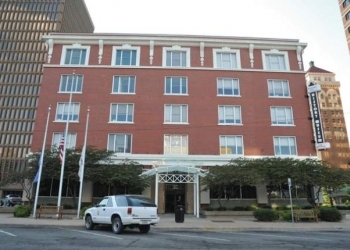News
City of Bartlesville
Posted: Oct 23, 2023 2:32 PMUpdated: Oct 23, 2023 2:32 PM
Bartlesville Water: Then and Now

Kelli Williams, City of Bartlesville
NOTE: This article originally was published in the City of Bartlesville's City Beat News Letter, which can be read HERE
How it started
The City of Bartlesville provides water not only to Bartlesville residents but to the entire region, including the cities of Dewey, Ramona and Ochelata, as well as five rural water districts in Washington, Nowata and Osage counties.
This is a huge undertaking, and one that the City of Bartlesville takes seriously — from the City Council, which must oversee routine items such as water-related agreements and contracts to more unpleasant tasks such as implementing rate increases when needed — to the Water Utilities Department technicians who treat the City’s potable water and monitor it at every point from intake to delivery.
Bartlesville’s water systems have changed greatly over the years, beginning even before the city was founded in 1897. Nelson F. Carr first built a rock dam across the Caney River in 1870 for his corn grinding mill, and Jacob H. Bartles added more rock and a masonry cap to the dam in 1875-76. The Caney River continued to be the city’s sole water supply well into the 20th century.
In 1914, the Bartlesville Water Company raised the dam two feet with a concrete application, where the present State Highway 123 road crosses it, to impound water and supply the water needs for the growing community. In 1937, an additional 3 feet brought it to its current height.
Water needs during these early years ranged somewhere around 1.2 million gallons of water per day (mgd) — far less than today’s annual average of 5.5 mgd with peak usage in the summer between 8-12 mgd.
Hulah and Hudson lakes
Records indicate the City of Bartlesville took over water distribution for the community around 1940, and that it was around that time that local and state officials began working with the U.S. Army Corps of Engineers to build Hulah Lake as a federal water resource project.
In addition to Hulah Lake, the City of Bartlesville commissioned and built Hudson Lake, located northwest of Bartlesville in Osage County. Hudson Lake was completed in 1949. In 1953, the City secured additional water rights for Hulah Lake, and the remaining rights were secured in 2010.
Construction of Hulah Lake provided a new source of water, but it accomplished much more than this. The lake also provided flood reduction to the Bartlesville community, which was greatly needed at the time. Multiple flooding events in the late 1930s and ’40s proved an urgent need for flood control, a need that was eased with the construction of the new lake as flood reduction benefits from the lake greatly reduced downstream flooding within the Bartlesville community.
Shortly after Hulah Lake was completed, in 1957, Bartlesville signed a water supply storage contract for 15,400 acre-feet, or 9.6 mgd. Smaller water supply storage agreements were also signed in 1970, for 2,200 acre-feet, or 1.4 mgd, and in 1980 for 2,100 acre-feet, or 1.3 mgd.
The drought of 2001-02
With Hulah Lake as the primary water source and flood control for downstream communities, the area’s water needs were largely met for several years.
That is, until severe drought conditions in 2001-02 prompted the City of Bartlesville to begin seeking alternative/additional water sources.
The City's primary water supply source, Hulah Lake, dipped down to just 17 percent of water remaining during this extreme drought, during which the City Council spent several meetings weighing options and discussing potential measures to reduce consumption. The council planned to impose restrictions on water use when heavy rainfall over a brief period of time in the Hulah Lake watershed filled the lake and ended the need for reduced consumption.
With the immediate threat removed, the City Council then formed a special committee, the Water Resources Committee, to explore how a similar situation might be avoided in the future by identifying potential sources of additional water supply for Bartlesville and the City's water customers.
The search for alternatives
In the early 2000s, the Water Resources Committee's work resulted in multiple studies being conducted to identify the most feasible options going forward. The most significant of these studies was the extensive U.S. Army Corps of Engineers Planning Assistance to States (PAS) study.
The PAS provided a guidepost for the committee and, ultimately, the City Council to follow, all but ruling out some options due to high cost with little water yield, such as dredging Hulah Lake, an often-suggested option still today.
"We get asked quite often why we don't just dredge Hulah Lake," said Terry Lauritsen, Director of Water Utilities. "There are several reasons, but essentially, dredging the lake would easily be in the $150 million-range, going by today's prices — and that’s a low estimate — and it would yield approximately 8 mgd of additional water for the region. Other factors that make this option unfavorable include a long permitting process and complications in disposing of the organic material with trace heavy metals, which is considered hazardous material by current federal laws, and the fact that silting would then reoccur over time, making this option less long-term than desired."
The PAS Study also looked at the following:
- The construction of a new lake, Sand Lake, by damming Sand Creek in Osage County ($130 million for 12 mgd).
- Obtaining water rights at Kaw Lake, located in Kay County, and installing the necessary infrastructure to utilize the water ($150 million for 14 mgd).
- Negotiate with the U.S. Army Corps of Engineers to purchase additional water rights at Copan Lake. (At that time, the cost of water rights at Copan lake was $2,800 per acre foot, which would have cost the City $7 million in total. For comparison, the City pays $68 per acre foot at Hulah Lake.)
- Reallocating a percentage of Hulah and Copan flood pool to water supply and installing the infrastructure to pipe the water to the City-owned Hudson Lake.
"The study also looked at accessing water at other regional lakes, including Birch and Oologah, but these lakes either didn’t have any water rights available or not a significant amount of rights to warrant further investigation," Lauritsen said.
"It was determined the most cost effective option was to purchase the remaining water storage rights at Copan Lake and reallocate 5 percent of the flood control at Hulah and Copan to water storage."
Federal assistance
Following the direction of the results of the study, City and elected officials began working with local and state representatives to obtain more affordable costs for rights at Copan Lake.
It took more than a decade, but the work began to pay off when then-Sen. James Inhofe was instrumental in brokering a deal between the City and the Corps of Engineers for 1 mgd at Copan Lake, thanks to a provision he authored in America’s Water Infrastructure Act of 2018. Instead of paying $7 million for these water rights, however, the City paid $200,000, which is a significant savings for Bartlesville water customers.
"As a result of the study's findings and information that has come to light since, in 2020, the City purchased the remaining storage rights at Copan Lake — 2,500 acre feet, or 1 million gallons a day," said Lauritsen. "It literally took a federal act of Congress and more than 12 years of work through the legislative process to keep the cost affordable for Bartlesville water customers. But the work paid off. Instead of paying $7 million for these water rights, the City paid $200,000, which is a significant savings for our customers."
In the years it took for this agreement to be possible, the City of Bartlesville continued to explore other, more viable options to meet the community’s water needs into the next 50 years and beyond.
Enter water reuse
In 2019, the City Council approved measures to facilitate the City’s ability to utilize the “Water for 2060 Law,” which will allow the City of Bartlesville to recapture treated wastewater after it is released upstream in the Caney River.
This project is essentially ready to implement but requires the proper permitting from the Oklahoma Department of Environmental Quality. That is anticipated to occur with the construction/expansion of the wastewater treatment plant, slated to start in 2025 and complete in 2028.
The water reuse system involves the construction/installation of infrastructure that will consist of a pump station at the wastewater treatment plant and an underground pipeline transporting the water to the Caney River just south of the County Road West 1500 bridge. This will allow the City to pump treated wastewater approximately 7 miles upstream of the Caney River Raw Water Intake and allow it to blend with existing river water, then send it to the water treatment plant for further treatment and, from there, to Bartlesville water customers.
This system, which is vital for the area to guard against drought in the future, will give the City access to up to 4 mgd of additional water and should meet area water needs 30 years into the future with the potential to extend area water resources another 60-70 years, depending on demand.
The drought of 2022-23
With water reuse not quite online yet as the system awaits completion of the regulatory process, Bartlesville experienced declining water supply levels beginning in the fall of 2022 and continuing through 2023.
This was driven by extreme drought conditions in Southeast Kansas, where the watersheds for Hulah Lake and Copan Lake are located. The watersheds are very near each other, with the Hulah watershed near Cedarvale, Kan., and the Copan watershed near Sedan, Kan.
To give some perspective on the severity of this drought, it should be considered that these areas, as of this summer, were below 20 inches of precipitation levels that are normal for this time of year. (The area received 21 inches of rain since the beginning of the drought, though normal rainfall is 40.5 inches.)
These drought conditions caused lake levels at Hulah and Copan to continue to decline, which negatively impacted Bartlesville’s overall water supply. At its lowest, overall supply reached 56 percent in July.
Another takeaway point: With the exception of 2023, Hulah and Copan lakes have never been less than 100 percent full as of June 1 of any given year. On June 1, 2023, Hulah was 42.3 percent and Copan was 58 percent full.
“We have never been in this situation before,” Water Utilities Director Terry Lauritsen said in June 2023.
Water Shortage Ordinance
A significant task completed by the Water Resources Committee following the drought of 2001-02 was the creation of the Water Shortage Ordinance, an ordinance that placed a high priority on conservation.
The ordinance was implemented for the first time in December 2022, when overall water supply began to decline due to lowering lake levels caused by drought conditions in Southeast Kansas.
The ordinance outlines four stages of drought based on the overall water supply remaining and the weighted water supply remaining.
Each stage beyond Stage 2 calls for escalating restrictions on outdoor water use and alters certain City operations. The ordinance also allows the City Council to impose emergency water rates in these later stage when overall supply and weighted supply (based on water rights) decline and voluntary conservation methods fail to lower consumption.
The Water Shortage ordinance was placed “on hold” briefly by the City Council in September 2023 pending further review by the Water Resources Committee in the wake of its implementation. The committee heard reports from City staff regarding the successes and limitations of the plan as it was implemented beginning in December 2022.
Some areas where staff felt improvement could be made were:
- More stringent rate increases for very high-use businesses, such as car washes
- Consistency in open/closures of public and private swimming pools
- Emergency rate increases
"Staff continuously received input from the public during the implementation of the ordinance," said City Manager Mike Bailey. "Two major points of concern were the fact that high-use businesses, such as car washes, were allowed to continue operating, and that the City-owned swimming pools did not open for the season while privately-owned pools were allowed to operate as normal."
He said emergency rate increases had a significant impact on consumption when first implemented, but that consumption began to increase again as soon as it was realized the rates were quite low.
"From Dec. 5, 2022, through April 3 of this year nearly every tool was used to communicate the status of the water supply and ask for conservation — social media, City Beat, utility bills, newspaper, radio and television," he said.
“Unfortunately, these measures did not do much to reduce water consumption. However, when the ordinance was modified in early April 2023 and the emergency water rates were implemented, consumption went down significantly.”
The WRC agreed to recommend higher emergency rates to escalate in later stages of the ordinance and to close all pools if the area enters Stage 4, which is considered emergency conditions.
The City Council approved the recommended modifications during its Oct. 2, 2023 meeting, removing the ordinance from its "on hold" status.
Where we are today
The Water Resources Committee is currently meeting regularly to continue its study of potential resources to enhance Bartlesville water supply.
The committee recently began narrowing a rather wide list of possibilities for long-term supply and recommended the City focus on the exploring the following areas:
Reallocation of 10 million gallons of water per day (mgd) of flood control to water supply at Hulah Lake, the City's primary water supply source.
- Securing the remaining 2 mgd at Copan Lake through a possible partnership with the town of Copan, and reallocation of 10.5 mgd of flood control to water supply.
- Explore potential partnerships with other communities and tribes to reduce the cost of acquiring water rights at Kaw Lake, located in Kay County. The lake has 40 mgd available; however, to acquire water rights and construct the infrastructure to access it would cost an estimated $150 million.
- Pursue a grant to further study the yield and sustainability for use of the Ada-Vamoosa Aquifer, located in Osage County.
The options, costs
To simplify things, following is a summary of the options available, the estimated costs and amount of water the City can secure. Keep in mind the projected average demand in 2065 is 8.2 mgd, and Hulah Lake’s estimated yield in 2065 is 4 mgd.
- Water Reuse — $10 million for 4.1 mgd
- Reallocate 10 percent of Hulah flood pool to water supply (includes additional pipeline) — $42.5 million for 10 mgd
- Secure remaining 2 mgd and reallocate 10 percent of Copan flood pool to water supply (includes a pipeline) — $70 million for 12.5 mgd
- Build Sand Lake — $130 million for 12 mgd
- Access Kaw Lake (includes pipeline) — $150 million for 14 mgd
- Dredge Hulah Lake — $150 million. This would recapture 8 mgd lost to sedimentation
Note that the most cost effective measures the City can take to ensure it can meet the area’s water needs into the future are to combine water reuse and reallocation at Hulah and Copan lakes.
These measures combined would result in a yield of more than 20 mgd for a total cost of about $95 million, compared to more expensive options for less yield.
The funding
The City typically funds these types of projects through low-interest loans from entities such as the Oklahoma Water Resources Board. Because these loans are very low interest and because the City has the ability to repay the loan over an extended period of time, this is the most cost-effective financing option available.
Any such loan would be repaid through water rates and/or Water Capital Investment Fees, which is an item included on monthly utility bills. These funds, which exist not only for water but also wastewater, are used to fund City utility infrastructure needs.
One of the most-often asked questions local water customers have regarding acquiring additional water rights and installing the necessary infrastructure to access it is, “How much will it increase water rates?”
Without the benefit of any detailed information at all, it’s difficult to answer the question. But it might help to consider that water rates nearly doubled after the $40 million water treatment plant was constructed nearly 20 years ago, and it was financed through a low-interest loan from the Oklahoma Water Resources Board.
So it’s fairly safe to say water rates would need to at least double or possibly triple to finance a project at the high end of the scale, say, a $150 million project.
It is for this reason the City has pursued the most cost effective measures — water reallocation and Hulah and Copan lakes and water reuse — rather than the most costly measures, such as pumping water from Kaw Lake. However, the recent drought has made it clear that further action may be needed.
Moving forward
As with most things of this magnitude, there is not a strictly linear path forward but rather the continuation of several steps that have been underway since the drought of 2001-02.
Elected officials — local, state and federal — City staff, and citizens continue to work together to improve the resources that are currently available and to identify new and innovative ways to add to our local water supply.
These steps, outlined in this guide and possibly others that have yet to be identified, will ultimately result in better utilization of the City's current water resources as well as secure additional sources of water for the future.
For more information, contact the Water Utilities Department at 918-338-4116.
« Back to News















